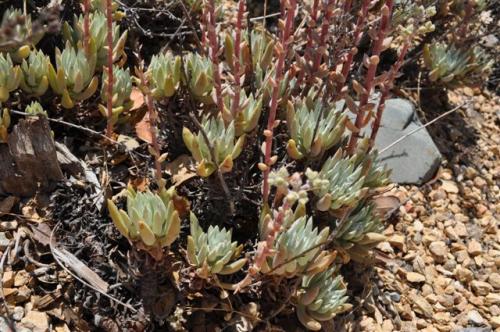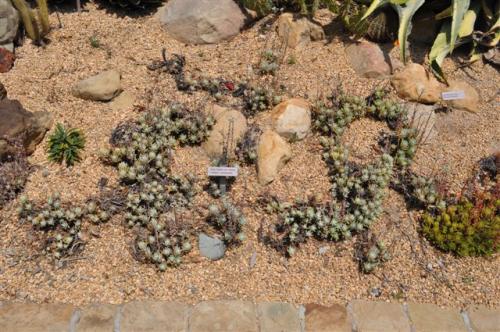CAMPANULATA Moran, 1978
Subgenus Stylophyllum
Distribution : Mexico (Baja California); West facing coastal cliffs.
Description (by J. Thiede in IHSP, 2003) :
Stems to 30 x 0.7 - 1.8 cm, covered with remains of dead leaves, richly branched and forming mound-like clumps to 60 cm in diameter with up to 150 rosettes.
Rosettes 3 - 8 cm in diameter with 12 - 30 leaves.
Leaves closely set, erect or upcurved, oblong-Ianceolate, acute or at first subacuminate, apiculate, serniterete, 2 - 4 (-6) x 0.6 - 1.3 cm, first farinose, later glaucous and dull green or somewhat purplish especially on the upper face.
Inflorescence 8 - 25 cm tall overall, reddish, glaucous, scape with 10 - 25 ascending branches, inflorescence obpyramidal, 4 - 12 cm in diameter with 2 - 5 simple or bifurcate ascending branches with 2 - 11 flowers, to 7 cm, pedicels 2 - 5 (-8) mm.
Flowers : Sepals 3 - 4 mm, deltoid, acute, 1.5 - 2 mm, corolla 10 - 16 mm in diameter, petals elliptic, acute, 8 - 10 x 3 - 4 (-5) mm, white or mostly tinged with pink along the keels, tube ± 2 mm.
Cytology : n = 68
Based on its octoploidy and the campanulate flowers, a hybrid origin between Subgen. Stylophyllum (possibly D. attenuata) and possibly subgenus Hasseanthus (probably D. virens ssp. hassei) or also a member of subgenus Dudleya is suggested in the protologue. The placement in subgenus Stylophyllum is merely for convenience.
At Santa Barbara Botanical Garden, CA, USA :


Photos Michael Wisnev